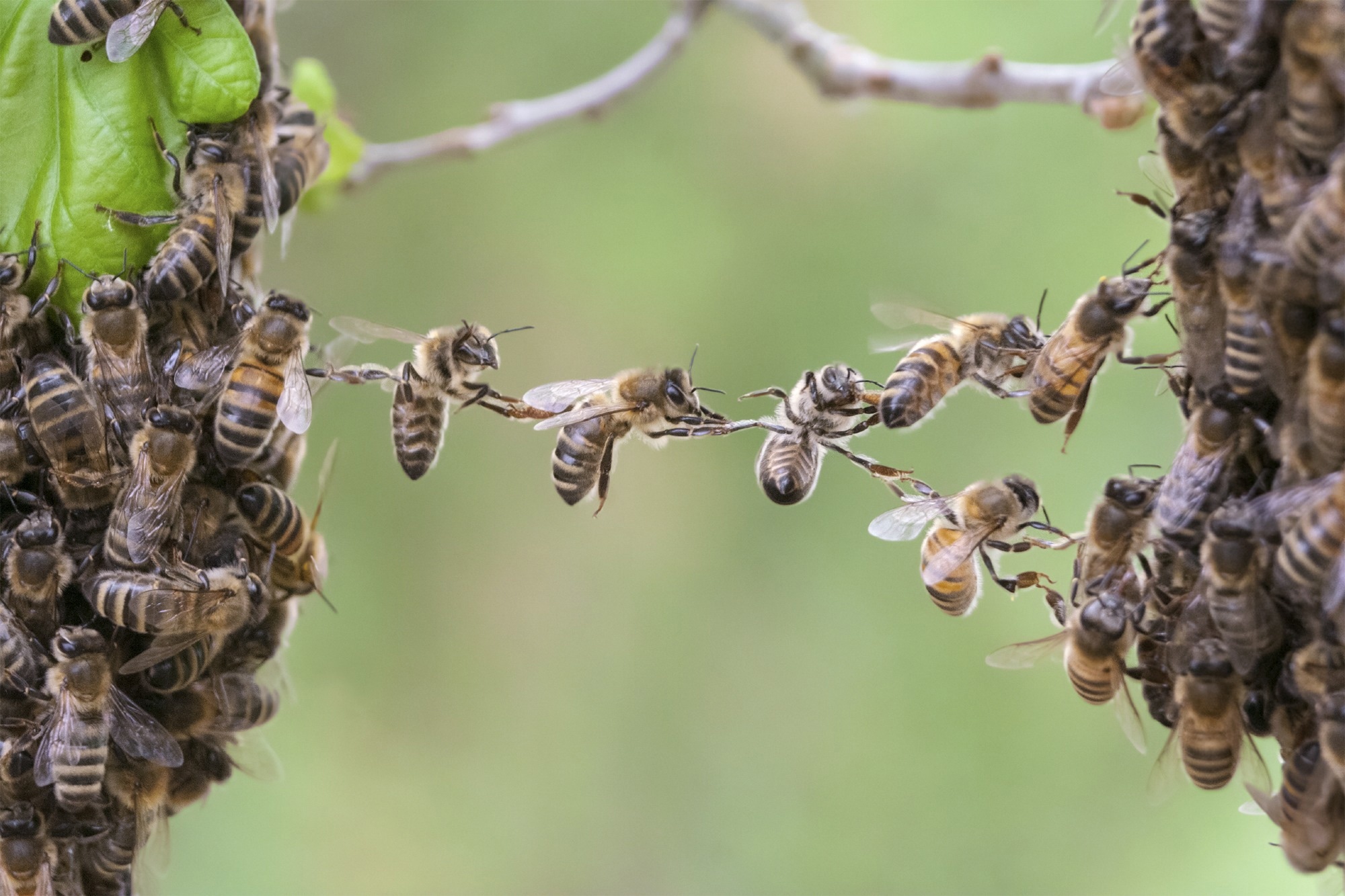 By Pooja Toshniwal PahariaReviewed by Lauren HardakerSep 25 2025
By Pooja Toshniwal PahariaReviewed by Lauren HardakerSep 25 2025In a recent study published in PLoS Biology, researchers investigated the genetic and molecular basis of sociability among honeybees. They analyzed food-sharing behavior (trophallaxis), integrating comparative genomics, transcriptomics, and genome-wide association analyses.
 Image credit: Viesinsh/Shutterstock.com
Image credit: Viesinsh/Shutterstock.com
They found genetic variants associated with brain activity patterns, including neuroligin-2, NMDA receptor 2B (nmdar2), and nuclear factor I X-type (Nf1), both implicated in human autism. This suggests conserved and divergent mechanisms of sociability across species. These findings advance understanding of honeybee sociality and shed light on the evolutionary roots of social behavior in animals.
Sociability varies widely among animals, influencing social networks from humans to honey bees. In colonies, some workers are highly connected, while others remain peripheral; yet this variation's genetic and molecular bases are poorly understood. Trophallaxis, the mouth-to-mouth exchange of liquid food, is a reliable indicator for sociability, linking interaction frequency to task specialization, health, and colony cohesion.
While advanced tracking can capture these behaviors in detail, the genetic and molecular factors behind them remain unknown. Honeybees, with their complex societies and tractable experimental systems, offer a powerful model for studying conserved and divergent mechanisms of social behavior.
About The Study
In this study, researchers combined behavioral, genomic, and transcriptomic analyses to explore the molecular basis of trophallaxis-driven social behavior in honeybees.
To minimize genetic variation, the team obtained worker bees from three colonies (R2, R8, and R41), each headed by a one-drone inseminated queen. They collected newly emerged bees (0–24 h) from incubated combs and barcoded them on the dorsal thorax. They introduced the barcoded bees into single-sided, glass-walled observation hives provisioned with honey and pollen paste. Bee colonies were monitored for ten days using automated imaging.
Trophallaxis events were detected when two bees were 1.7–7.4 mm apart and oriented face-to-face, and a convolutional neural network (CNN) confirmed proboscis insertion at 90% sensitivity. Positional and orientation data indicated locomotion and turning speeds, while information partial directed coherence (iPDC) values quantified social influence during proximal encounters.
Following behavioral monitoring, researchers assayed subsets of bees for division-of-labor–related behaviors, including nursing, guarding, foraging, and aggression. Intruder assays assessed aggression (guarding), while larval provisioning tasks indicated affiliative caregiving (nursing). Automated entrance monitoring tracked foraging. The behavioral assays categorized bees as guards, nurses, foragers, generalists, or non-responders.
Deoxyribonucleic acid (DNA) was extracted from the thoraces of 391 individuals and subjected to whole-genome resequencing. The researchers conducted a genome-wide association study (GWAS) to identify single-nucleotide polymorphisms (SNPs) associated with the movement parameters and frequency of trophallaxis. To assess differential gene expression, transcriptomic profiling was performed on ribonucleic acid (RNA) obtained from mushroom bodies (MBs) of 176 bees, representing distinct behavioral categories. Gene Ontology enrichment identified pathways associated with sociability.
To further characterize NLG2, a candidate gene emerging from GWAS and RNA sequencing, spatial expression was analyzed using fluorescent in situ hybridization (FISH) across developmental stages (days 1, 7, and 14). Confocal microscopy enabled visualization of localized expression within MBs, linking gene activity to behavioral maturation.
Results
A GWAS integrating over two million SNPs from 357 worker honeybees identified 18 loci significantly associated with variation in trophallaxis frequency, distributed along nine chromosomes. The team found 11 SNPs localized within introns of annotated genes, including two in NLG2 and two in nmdar2. The team identified additional intronic variants in NF1, angiogenic factor with G patch and FHA domains 1 (AGGF1), CCR4-NOT complex subunit 6-like (CNOT6L), and nephrin. By contrast, GWAS of turning and locomotion kinetics yielded no significant association, indicating that the genetic signals were specific to social interaction rather than general motor activity.
Comparative bioinformatic analyses confirmed one-to-one orthology with Drosophila melanogaster, implicating NLG2 and nmdar2 as “high confidence” autism risk genes [Simons Foundation Autism Research Initiative (SFARI) Category 1]. The analysis grouped NF1 under syndromic autism genes. The authors emphasized that these are associations, not demonstrated causal variants.
Transcriptomic profiling of the brain revealed differential expression of genes linked to neural signaling and development, with NLG2 expression in MBs strongly correlated with trophallaxis frequency and social responsiveness. Whole-mount FISH demonstrated robust NLG2 localization in MB Kenyon cells, MB extrinsic neurons, and the pars intercerebralis. Expression levels were developmentally dynamic, with elevated transcription in one-day and 14-day workers and reduced levels in a week, paralleling behavioral maturation and task transitions.
At the colony level, bees from colony R41 exhibited markedly lower trophallaxis rates, reduced interpersonal synchrony, and enrichment of the alternative NLG2 allele. Polygenic risk score regression showed negative associations between trophallaxis-associated SNPs and bidirectional movement influence (Iflow), connecting genetic variation to reduced motor synchrony within social networks.
Across transcriptomes, 785 and 920 genes showed negative and positive correlations with sociability, respectively. Signaling genes, such as neural cadherin, neurexin-4, synaptogyrin, and synaptotagmins-1, 4, 7, and 10, showed positive associations with the frequency of trophallaxis. Gene Ontology enrichment highlighted regulatory pathways in cellular communication for positively correlated genes, whereas negatively correlated genes showed enrichment for translational and macromolecular biosynthetic functions.
Notably, “non-responder” bees showed distinct transcriptomic profiles, highlighting that low sociability is underpinned by its molecular signature rather than simply lacking other behaviors.
The study reveals that honeybee food-sharing sociability is shaped by specific genetic variants, particularly neuroligin-2. It highlights associations that reflect both conserved and lineage-specific molecular mechanisms underlying social behavior across species.
Download your PDF copy now!
Journal Reference
Traniello IM et al. (2025). Genetic variation influences food-sharing sociability in honey bees. PLoS Biol., 23(9): e3003367. DOI: 10.1371/journal.pbio.3003367. https://journals.plos.org/plosbiology/article?id=10.1371/journal.pbio.3003367